Schneider Shorts of 20 January 2023 – an Imperial retraction, investigators appointed in Stanford, a sexual harasser arrives in Harvard, greedy crook reverses ageing, with another Cassava paper whitewashed, the secret of high impact factors, why some Italian fraudster’s papers are safe.
Table of Discontent
Science Elites
- Subsidiary retraction – Imperial piss-takers retract clinical study lacking ethics approval
- Mistakes are inevitable – Stanford President Marc Tessier-Lavigne faces investigation by Randy Schekman
- No intentional attempt to deceive – German plant scientist Marcus Wirtz reluctant to fix paper
- Mechanisms of Fraud – Meet an Italian biomedical researcher named Sabbatini
- Sexual harasser in Harvard – Michael Balter warns of David Lordkipanidze
Science Breakthroughs
- Aging reversed – all thanks to David Sinclair’s greed
Scholarly Publishing
- Be aware of conflicts of interest – J Clin Investigation whitewashes Cassava fraud
- How to impact – elite journals’ secret for huge impact factor are authors like Fazal Raziq
News in Tweets
Science Elites
Subsidiary retraction
An unexpected setback for the piss-takers of the Imperial College London in UK, Murdoch University in Australia, and their professors who own the failed biotech startup Melico.
Imperial Piss-Take
“Having reviewed the Conflict of Interest disclosures made by Professor Frost, Professor Holmes and Dr Garcia-Perez, and having also reviewed additional information concerning their company, Melico, […] the College is satisfied that they have no undisclosed or unmanageable conflicts of interests” – Arts Bachelor (Honours)
I previously wrote how Imperial College was utterly unconcerned by the absence of an ethics approval in this clinical study:
Isabel Garcia-Perez , Joram M. Posma , Edward S. Chambers , John C. Mathers , John Draper , Manfred Beckmann , Jeremy K. Nicholson , Elaine Holmes , Gary Frost Dietary metabotype modelling predicts individual responses to dietary interventions Nature Food (2020) doi: 10.1038/s43016-020-0092-z
On 1 November 2022, the British Human Research Authority (HRA) informed me:
“…in July 2022 the Research Ethics Committee (REC) identified that a breach had occurred due to the additional feeding study, which is referred to in the Nature Foods publication, being conducted without a favourable ethics opinion from the REC in place. We have been informed that the research team had believed that the study had ethical approval under the favourable opinion of the main study (REC reference: 13/LO/0078), however the REC had not been informed that a further study would be undertaken and the sub-study documentation had not been approved for use. […]
Finally, the term ‘subsidiary’ ethics approval is not one that is used or recognised by the HRA. We have recommended that the sponsor contacts the journal to notify them that the sub-study did not have ethical approval and that the reference to subsidiary ethical approval should be removed.”
I informed the journal, which never replied to me, but issued an Editor’s Note on 14 November 2022. And now, on 13 January 2022, this paper was retracted:
“The Chief Editor has retracted this article. The London–Brent Research Ethics Committee has informed the Chief Editor that, contrary to the statement in the article, the semi-controlled four-day feeding study utilised in this research and presented in the supplementary information, did not have approval. The authors have been invited to submit a new manuscript without this sub-study for peer review. All authors agree with this retraction.”
What the note failed to mention, is that the Melico-owning authors also lied about having “no competing interests” while promoting Melico technology in that paper.
Mistakes are inevitable
Washington Post has an update on the affair of the fake data in the papers of Stanford’s President, Marc Tessier Lavigne. For the backstory, read here:
Toppling Giants in Stanford
Everyone is talking about Stanford’s President Marc Tessier-Lavigne now. OK, let’s talk about him, and how Stanford deals with research fraud. And then let’s talk about Thomas Rando.
So here is what WaPo tells:
“Some scientists have noted that Tessier-Lavigne has an enormous and influential body of work that has stood the test of time and been validated by researchers around the world.
Seven Stanford professors, several of them National Academy of Sciences members, wrote a letter to the Stanford Daily in Decemberurging people not to rush to judgment. They wrote that Tessier-Lavigne’s research had revolutionized understanding of how the brain is wired.
“Scientific integrity and data reproducibility are paramount to what we do,” wrote professors Aaron D. Gitler, Liqun Luo, Robert Malenka, Susan K. McConnell, William T. Newsome, Carla J. Shatz and Kang Shen. “Nevertheless, errors do occur in science — and when they do, there are several options for making corrections, depending on the severity of the error. Questioning a researcher’s scientific integrity is a very serious allegation that should not be confounded with the detection of errors in a few papers, particularly against a backdrop of work that has been widely replicated by others.”
They wrote that other authors of the papers have taken responsibility for some errors, but that they believe it is appropriate to review three papers published in 1999 and 2001 on which Tessier-Lavigne is the senior author.”
The letter also mentioned that “it is unfair to question a scientist’s integrity based on images produced from a collaborator’s laboratory“, and that “In science, as in all realms of life, mistakes are inevitable.“
Nobody discusses why Tessier-Lavigne ignored the massive fraud evidence in his papers for 7 years and why he gave the main suspect, his somewhat unhinged protegee Elke Stein, a job in Stanford. In fact, nobody ever mentions Stein’s name. Your guess is as good as mine as to why everyone wants to divert attention from this special lady friend of Stanford’s president.
WaPo also reports that Stanford’s board of trustees recruited “Mark Filip, a former federal judge and former deputy attorney general at the Justice Department and his law firm, Kirkland & Ellis“, and appointed an investigative committee to deal with Tessier-Lavigne’s case:
“On Friday, [committee’s chair, trustee Carol Lam] announced that Filip had engaged a panel of experts: Hollis Cline, chairman of the neuroscience department at the Scripps Research Institute; Kafui Dzirasa, Howard Hughes Medical Institute investigator and associate professor of psychiatry and behavioral sciences, biomedical engineering, neurobiology, and neurosurgery at Duke University; Steven E. Hyman, professor of stem cell and regenerative biology and provost emeritus at Harvard University; Randy Schekman, Howard Hughes Institute investigator and professor of cell and developmental biology at the University of California at Berkeley and 2013 Nobel laureate in Physiology/Medicine; and Shirley M. Tilghman, professor of molecular biology and public affairs emerita, and president emerita at Princeton University.”
Now Shekman is a promising choice, he always fought against the elitism in academia.
No intentional attempt to deceive
Let us now see how German scientific elites deal with problems in their papers.
In November 2019, concerns were raised about this plant biology study:
Yihan Dong , Marleen Silbermann , Anna Speiser , Ilaria Forieri , Eric Linster , Gernot Poschet , Arman Allboje Samami , Mutsumi Wanatabe , Carsten Sticht , Aurelio A. Teleman , Jean-Marc Deragon , Kazuki Saito , Rüdiger Hell , Markus Wirtz Sulfur availability regulates plant growth via glucose-TOR signaling Nature Communications (2017) doi: 10.1038/s41467-017-01224-w

The lead author is Marcus Wirtz, group leader in the lab of the University of Heidelberg professor Rüdiger Hell. There were other concerns flagged, but let us focus on the duplicated bands in Fig S1a. In November 2019, Wrtz insisted on PubPeer:
“However, there is a small dot in the right corner of the wild type signal that is absent in the T-DNA insertion signal that has been labelled in red”
He did however announce to investigate, and in March 2022 announced on PubPeer that the results were reproduced and reliable. I wrote to Wirtz and Hell then, and received this reply from the former (translated):
“Unfortunately, it is no longer really possible to understand how this mix-up/duplication of signals came about. However, we are certain that there was no intentional attempt to deceive on the part of the employees.”
I asked if this means he admits the band duplication, and intends to issue a correction, but Wirtz has never replied since.
In June 2021, this was found:
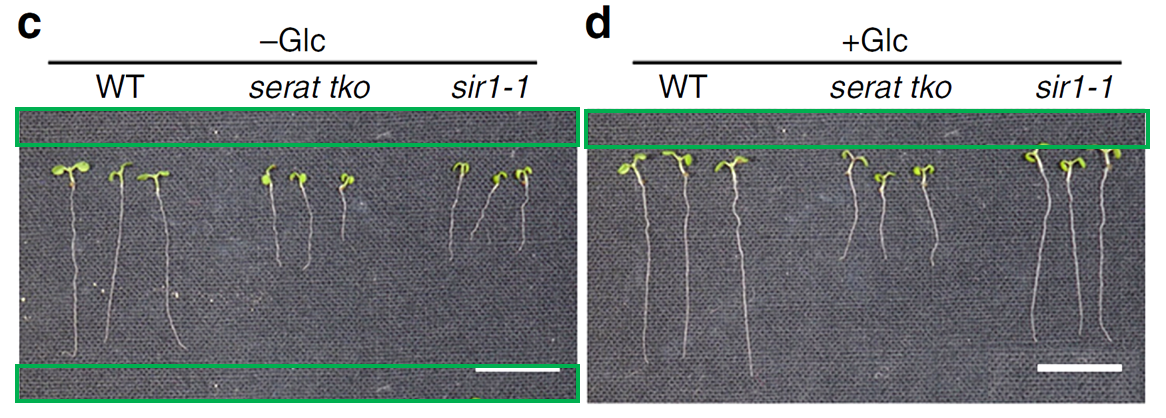
Wirtz explained on PubPeer that the image was merely re-arranged and posted the original. Other PubPeer users reminded him of Nature‘s policy on image integrity:
“The use of touch-up tools, such as cloning and healing tools in Photoshop, or any feature that deliberately obscures manipulations, is unacceptable.”
Maybe when you are used to digitally alter data, you just do it by default even where unneeded, like Figure 4c? Because this was what was found most recently:
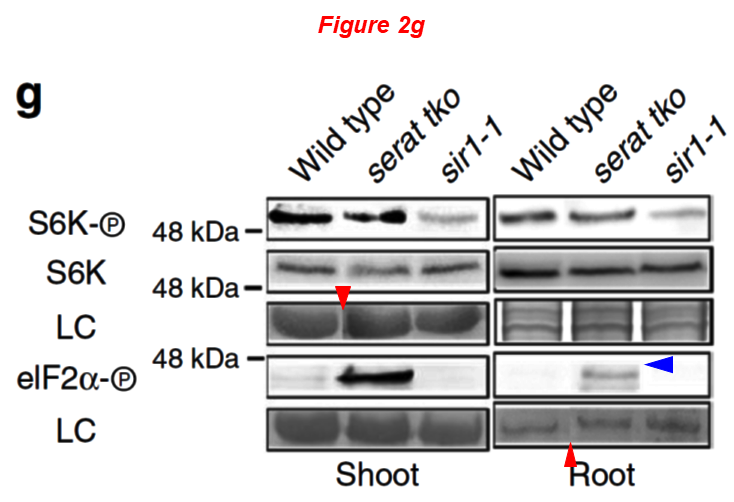
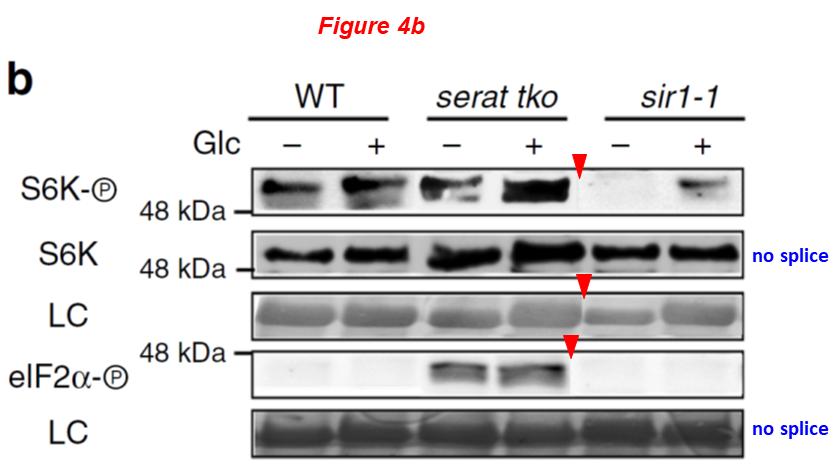
Wirtz and Hell again didn’t reply to my email when asked to clarify.
Mechanisms of Fraud
There is a scientist called Maurizio Sabbatini, who is of course not related to the mTOR man, the research cheater (and sexual predator) David Sabatini. The Sabbatini you will meet now is associate professor at the Università degli Studi del Piemonte Orientale in Novara, Italy, and his science is very unprofessionally and incompetently forged. So lazily that he won’t get his own article, just a place in Shorts.
Sabbatini was caught by Aneurus inconstans (assisted by ImageTwin software) who was chasing some Sicilian fraudsters whose wider connections at the University of Camerino (in central Italy) eventually led the sleuth to the biomedical scholar who once worked there and is now professor in Piedmont.
Maurizio Sabbatini , Daniele Tomassoni , Francesco Amenta Hypertensive brain damage: comparative evaluation of protective effect of treatment with dihydropyridine derivatives in spontaneously hypertensive rats Mechanisms of Ageing and Development (2001) doi: 10.1016/s0047-6374(01)00318-9
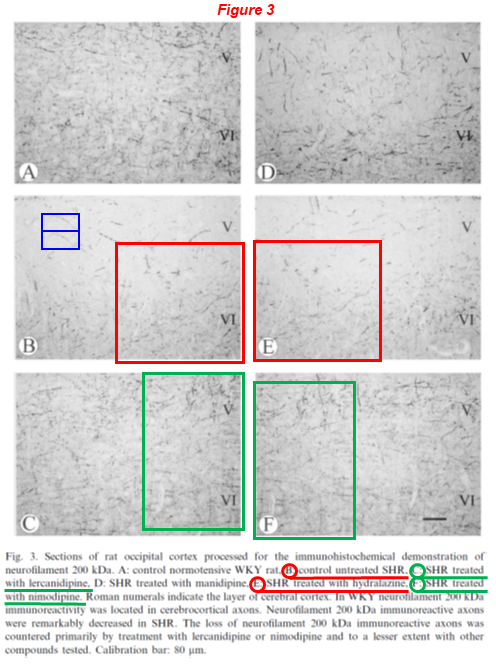
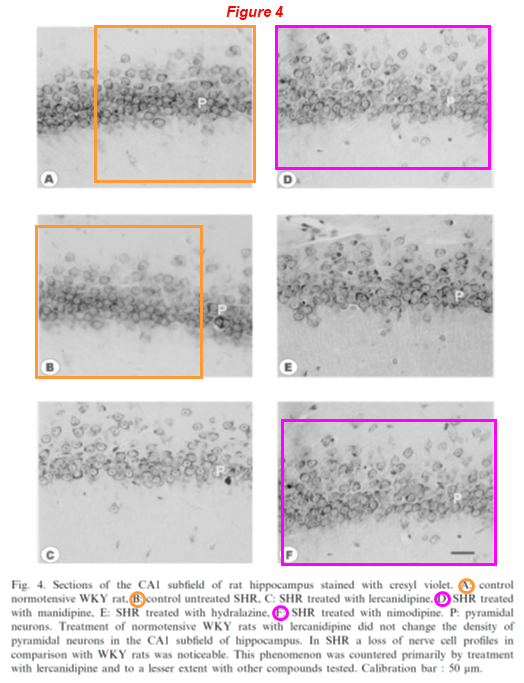
It gets worse.
Maurizio Sabbatini , Amedeo Leonardi , Rodolfo Testa , Daniele Tomassoni, Lucia Vitaioli , Francesco Amenta Effects of Dihydropyridine-Type Ca 2+ Antagonists on the Renal Arterial Tree in Spontaneously Hypertensive Rats Journal of Cardiovascular Pharmacology (2002) doi: 10.1097/00005344-200201000-00005
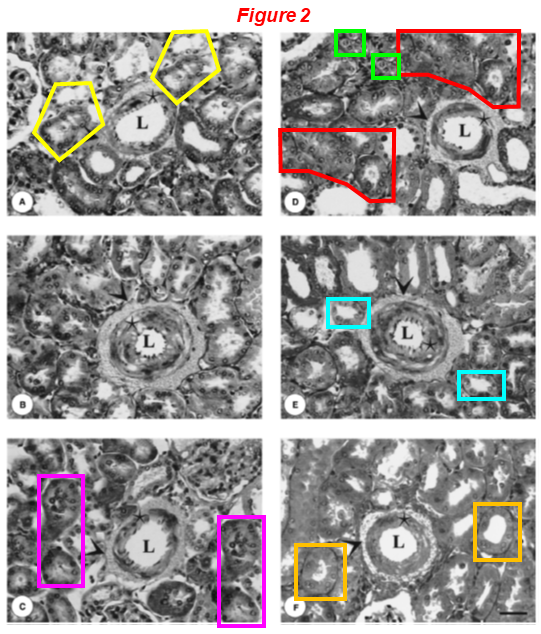
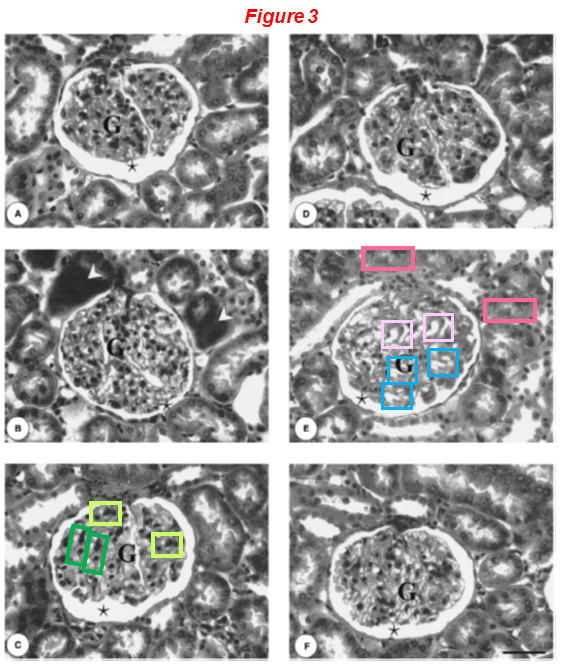
Sabbatini retorted on PubPeer:
“Many microphotograph from stained histological sample are the result of image software processing to improve the contrast and make the details of the organ’s microanatomy more visible. This process can eliminate some differences in microanatomical details by making parts of the organ apparently similar or much more similar than it actually is.“
Maurizio Sabbatini, Daniele Tomassoni , Francesco Amenta Influence of treatment with Ca2+ antagonists on cerebral vasculature of spontaneously hypertensive rats Mechanisms of Ageing and Development (2001) doi: 10.1016/s0047-6374(01)00233-0
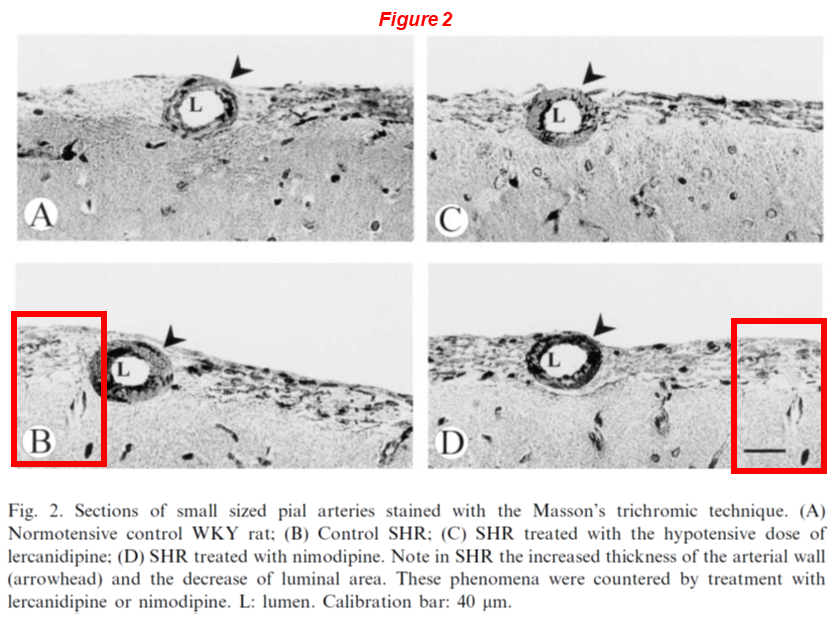
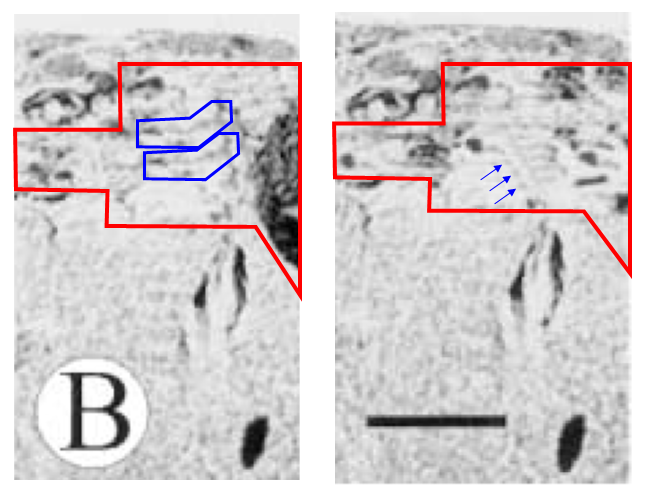
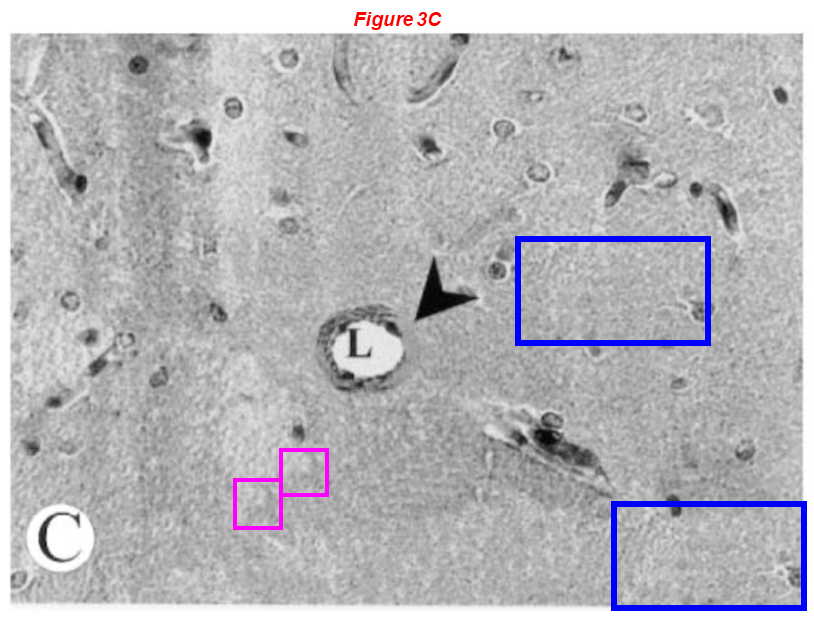
Sabbatini remained unconcerned:
“The answer is always the same. The indicated frame evidences a classical technical artefact, that can be found with a relative frequency in microphotographs
Figure 2 in B and D the frames evidence a typical pictures of a capillary profile, as can be found in frequently in paraffin stained section, the other spot being typical fibroblast nucleus. Their apparent similar position is just a coincidence. In figure 3C, I do not observe any similarity“
How about this one:
Maurizio Sabbatini , Assia Catalani , Claudia Consoli , Nunzio Marletta , Daniele Tomassoni, Roberto Avola The hippocampus in spontaneously hypertensive rats: an animal model of vascular dementia? Mechanisms of Ageing and Development (2002) doi: 10.1016/s0047-6374(01)00362-1

Here, Sabbatini commented on Pubpeer:
“Indeed, this is a curious event. However, despite the apparent identity of the indicated frame, I observe no such perfect identity: The white circle has different diameter in the two red frames, furthermore, in figure D it is bordered by a faintly grey border the is not present in image F. My impression is that it is not due to the use of different lighting. At the edge of image F, appear a spider-like spot appears, not present in image D, it should be there in any case. Again, in the middle of the red frame in F, a spot appears that should be also visible in F, but it is not. At the bottom of the frame in D and F a faintly visible circle appears accompanied along its edge from two spots. This particular element is the consequence of aqueous crystal condensation that generate this formation in high-thick sections. In conclusion, images are taken from high-thick sections and processed for immunohistochemistry. The antibodies available in the 2000s were valid at detecting the specificity of the signal, but not equally able to offer the good cellular picture, so it is not surprising that similar elements can be detected. This is just one case. Thank you for your remark Sincerely“
The dude doesn’t even understand that those minor differences actually block the escape route of “innocent mistake of accidental image reuse” and prove someone’s intentional research fraud. Sabbatini did not reply to my email.
The good news for Sabbatini is that the Editor-in-Chief of the Elsevier journal Mechanisms of Ageing and Development is Efstathios Gonos This Greek professor at the National Hellenic Research Foundation in Athens likes to talk tough about research integrity while covering up massive image fraud with idiotic corrigenda which blame the camera manufacturer Olympus (sic!) for the fraud, pardon, unaltered conclusions and reproducible results.
The impossible Toni Camins
They are professors of molecular biology and they don’t know how microscopy or western blots are supposed to work. But it passed peer review!
Gonos is also Editor-in-Chief of another journal, IUBMB Life at Wiley. Which became target of Chinese paper mills, uncovered by Smut Clyde, and also there Gonos bleated something about being tough on fraud and then did exactly nothing. Not one papermill forgery was retracted.
The scientific sea of miR- and exosome-related knowledge
“Whole cohorts of peer-reviewers have been trained to view all these mannerist stylings as what western blots should look like. […] It will be a challenge to convince them otherwise.” – Smut Clyde.
It’s not just Gonos. I contacted one of the associate editors of Mechanisms of Ageing and Development, the Cologne professor Björn Schumacher. He warned me not to reproduce anything from his emails to me. I asked if that was a lawsuit threat: silence back, which speaks for itself.
Proper channels, eh?
Sexual harasser in Harvard
Harvard University decided to host a very special scientist from Georgia (the country in Caucasus, not the US state ruled by “Caucasians”). This scientist is David Lordkipanidze, and he was previously exposed as a sexual harasser.
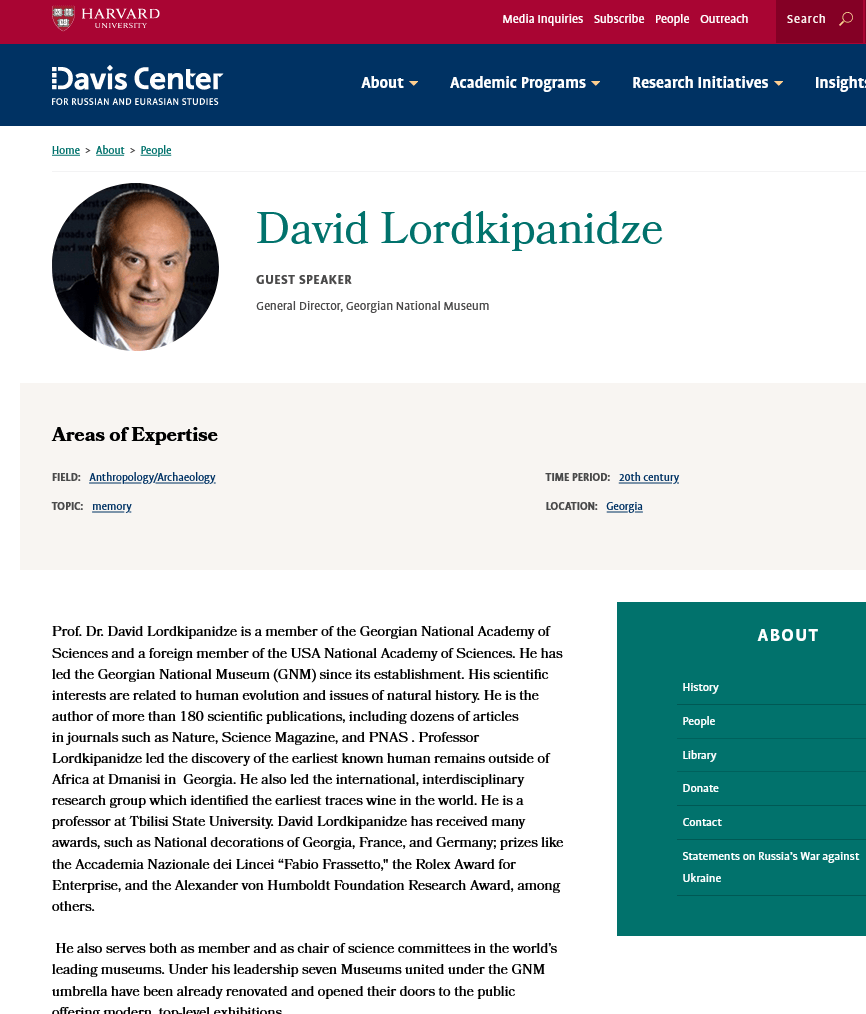
The #MeTooSTEM journalist Michael Balter exposed Lordkipanidze’s sexual abuse already in 2018:
“On May 2, 2017, Diane (not her real name), an anthropologist at a university in the northeast United States, posted a description of her own experiences on a popular science blog to which she is a regular contributor. Under the heading “In case this helps you: This happened to me while I was trying to become a paleoanthropologist,” Diane described being sexually assaulted in 2003 by the director of a Homo erectus field site.
Diane did not name the site nor the director in her original blog post. But as the link quickly spread on social media, she invited colleagues to ask her who she was talking about. They did, and she responded, “David Lordkipanidze.” He is the leader of excavations at the famed site of Dmanisi in Georgia, about 55 miles southwest of the capital, Tbilisi. Lordkipanidze, who rose to prominence after the discovery of numerous early human skulls and other human fossils at Dmanisi, is also the general director of the Georgian National Museum in Tbilisi. […]
Lordkipanidze flatly denies assaulting Diane as well as other women who have made similar charges against him. And a number of Lordkipanidze’s colleagues working at Dmanisi have come to his defense, insisting that they have never observed him engage in misconduct. But others describe a chronic pattern of harassment and inappropriate behavior with women, stretching over a period of at least 15 years. And Diane’s claims are supported by at least four contemporaneous witnesses who say she told them about the alleged assault either immediately or shortly afterwards.”
Balter has the details of that attack, and of other:
“But Lordkipanidze’s behavior was not restricted to Dmanisi itself. Another woman says he attacked her at a conference in the United States in 2011. The alleged victim says that following a dinner meeting with Lordkipanidze, he asked her to stop by his hotel room so he could retrieve some literature about Dmanisi for her. Inside the room, after rebuffing one advance from him and thinking he had accepted that she was not interested, the victim suddenly found herself pinned down on a couch with Lordkipanidze forcibly kissing her.”
Of course many of Lordkipanidze’s colleagues and mentees, male and female, insist he never sexually harassed them which means these women must be either either lying or ungrateful of the lavish attention the mighty scholar bestowed upon them.
“A male scientist who worked at Dmanisi also describes the party atmosphere at the site. “There were quite often large parties at the field house, especially when international teams would come visit, with music, dancing, and drinking competitions.” During these parties, a second researcher who attended them in those early days says, “whenever I would see [Lordkipanidze] he would be sitting as close as he could sit to a female student or kissing her on the cheek or the neck.” This researcher says that the women would typically be wearing tense smiles, “trying not to offend him”
Lordkipanidze is often celebrated to be a great science populariser, maybe because he regularly invited friends outside of science to meet his female students:
“But the other four, all women who attended the field school in 2015, told a somewhat different story. Each of the four described situations that made them uncomfortable. One says that on the evening of Lordkipanidze’s birthday party, two men she had not seen before arrived for the celebrations. “I had no idea who they were or why they were at the field school, but all the Georgians seemed to know them, so I assumed they were part of the Georgian Museum. It became evident, very quickly, that the only reason they were there was to pick up girls.” The student says that the men focused their attention on two students in particular, although she was not one of them.
A second student says that one evening, in the midst of some heavy drinking, a young Georgian man who was working on the excavations pulled one of her female fellow students away and got her in a location that was out of sight of the others. Shortly afterwards the woman could be heard yelling, and her colleagues had to intervene to pull the man from on top of her. They did not report this episode to the leaders of the field school, however.”
Here is why everyone remained silent:
““It was common knowledge that Lordkipanidze was a sexual predator at the field house at Dmanisi, and that sexual harassment was basically institutionalized there and facilitated by his staff,” says another archaeologist who also worked at the site in the early days. “Often times my fellow archaeologists would commiserate about his predatory behavior, but we were very aware that we were guests in a foreign country. To impose our values and ethical standards on another culture, albeit reprehensible in our view, is against a foundational principle of anthropology, the concept of cultural relativism, where we accept cultures on their own terms without judgement.””
But now Lordkipanidze with his exotic Georgian culture arrived to USA. Maybe Harvard will just pay some sex workers to dress up as early career researchers, to keep their guest happy and to avoid Title IX lawsuits?
This by the way is from the Davis Center’s statement from 25 February 2022:
“The Davis Center stands with the people of Ukraine and with the many people around the world who are and will be harmed by this war.”
While russian soldiers rape Ukrainian women, men and children, this Harvard institute invited a sexual harasser from a country ruled by homophobic oligarchs who see russia as their main ally.
Oh well, in 2022 the German Goethe Institute awarded Lordkipanidze with a Goethe Prize. Correction: The office of the President of the Goethe Institute informs me now:
“The Goethe Medal was awarded many years ago and took place in 2016, long before the blog article you mentioned. We take the hint very seriously, will take a closer look at the case and also get in touch with the responsible colleagues.“
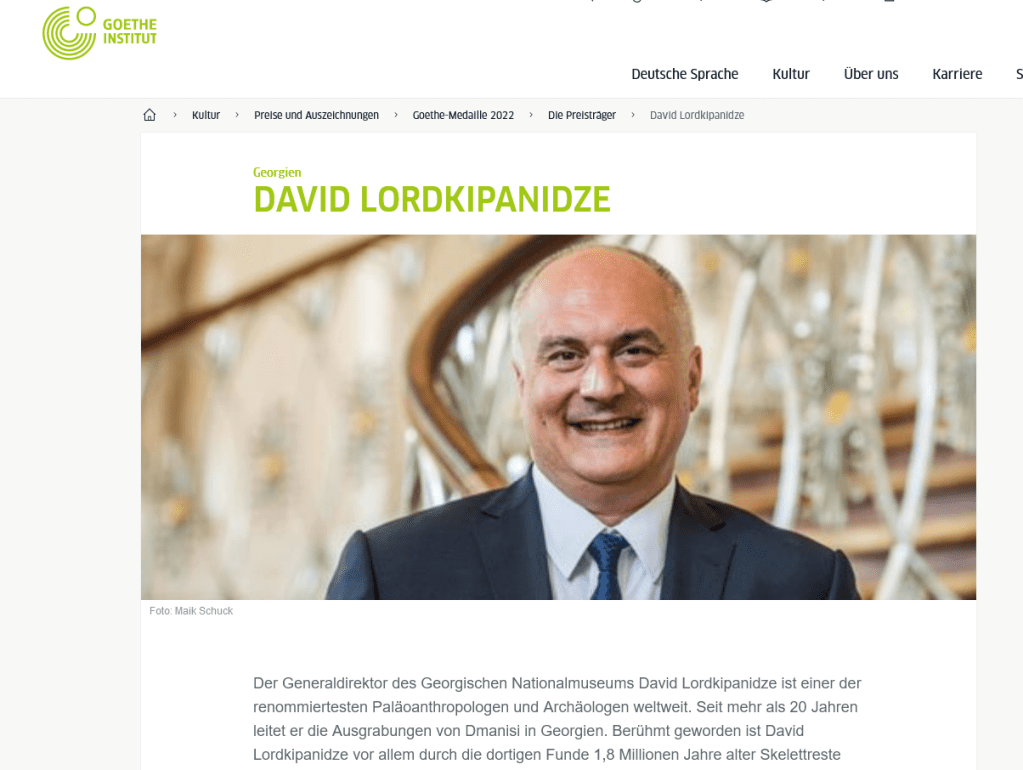
Science Breakthroughs
Aging reversed
Amateur wannabe science journalists like myself should learn science reporting from the very best. And who can be better than the non-profit extert journalists of Science?
A story of an amazing scientific breakthrough was reported on 13 January 2023, under the headline “Two research teams reverse signs of aging in mice“:
“A decade after Kyoto University biologist Shinya Yamanaka won a share of a Nobel Prize for discovering a cocktail of proteins that reprogram adult cells into versatile stem cells, two teams argue the proteins can turn back the clock for entire organisms—perhaps one day humans. One group at a biotech used gene therapy to deliver some of the so-called Yamanaka factors into old mice, and modestly extended their life span. And a separate team followed a similar strategy to reverse aging-like changes in genetically engineered mice.”
This was the first group:
“Several groups had already found genetically engineered mice that begin expressing Yamanaka factors in adulthood show reversal of certain aging symptoms. To explore an approach that might lead to a more practical treatment for people, San Diego–based company Rejuvenate Bio injected elderly (124-week-old) mice with adeno-associated viruses (AAVs) carrying genes for three of the factors, collectively known as OSK.
These animals lived another 18 weeks on average, compared with 9 weeks for a control group, the company reported in a preprint on bioRxiv this month. They also partially regained patterns of DNA methylation—a type of epigenetic mark—typical of younger animals. Although some studies have suggested Yamanaka factors can promote cancer, Noah Davidsohn, Rejuvenate’s chief scientific officer and co-founder, says the company has so far found no obvious negative effects in mice given the gene therapy.”
This is the biotech start-up’s preprint:
Carolina Cano Macip, Rokib Hasan, Victoria Hoznek, Jihyun Kim, Louis E. Metzger IV, Saumil Sethna, Noah Davidsohn Gene Therapy Mediated Partial Reprogramming Extends Lifespan and Reverses Age-Related Changes in Aged Mice bioRxiv (2023) doi: 10.1101/2023.01.04.522507
The company is currently preparing a therapy of FGF21 and a soluble TGFb receptor combo for “cardiac, metabolic, renal, animal health” fields. Guess who sits on their scientific advisory board.
Of course George Church, because this mega-bullshitter sticks his snout into any trough with anti-ageing money.
What is the other breakthrough Science wants us to know about?
“The second study, published yesterday in Cell, is from a team led by Harvard Medical School geneticist David Sinclair, who has backed several controversial “antiaging” interventions over the past 2 decades. (Rejuvenate’s approach grew from an earlier collaboration between Sinclair and Davidsohn, but Sinclair isn’t involved in the company’s research, Davidsohn says.)” […] The findings point to a way to drive an animal’s age “forwards and backwards at will,” Sinclair says, and support the idea of epigenome-targeting treatments for aging in humans.”
Sinclair again, for f***’s sake.
Never-ageing Anti-aging to cure COVID-19
Scientists David Sinclair and Michael Lisanti have an ingenious solution to COVID-19: anti-aging drugs. If a disease kills old people, stop being old!
Because in America capitalism beats animal welfare anytime, this multimillionaire scammer and bullshitter, a Harvard professor with many problematic studies flagged for data manipulation on PubPeer, is allowed to torture monkeys to get even richer:
“Still, both groups want to move their work toward the clinic. Rejuvenate is examining the mechanisms underlying the treatment’s action and tweaking its delivery and composition, Davidsohn says. “OSK might not be the final set” of factors, he adds. Sinclair says his team is already testing AAV-delivered OSK in the eyes of monkeys. “If those studies in monkeys go well and everything looks safe enough for humans, the plan is to immediately apply to the FDA [Food and Drug Administration] to do a study in one or more [age-related] diseases of blindness.””
Scholarly Publishing
Be aware of conflicts of interest
Nature brought an article about the new policy at the society-owned Journal of Clinical Investigation, where whistleblowers now must declare their conflicts of interests so the editors find a ground to reject their evidence. It was about this editorial which I covered before.
Elizabeth M. McNally Conflicting interests: when whistleblowers profit from allegations of scientific misconduct Journal of Clinical Investigation (2022) doi: 10.1172/JCI166176
McNally’s decision to crack down on conflicted whistleblowers was motivated by the fact that some of them traded short-stocks of Cassava Sciences, a fraudulent biotech startup which ran fraudulent clinical trials and published fraudulent papers to push a fraudulent Alzheimer’s cure. That Photoshop fraud was for some reason was defended by several allegedly respectable journals, e.g. the society-owned Journal of Neuroscience. Read here:
Facts and Fiction of Cassava Sciences
Attack is the best form of defence. Especially when your commercial clinical research is tainted by preclinical Photoshop fraud.
Cassava fraud and Alzheimer’s capitalism
“even Theranos didn’t submit fake data to FDA”
The reason I found this Nature story useful is a tiny side-note somewhere in its text.
” McNally says she hopes that her JCI editorial will remind other journals to be aware of conflicts of interest. (JCI’s investigation of the allegedly doctored image in its paper did not substantiate the whistle-blowers’ claim, she says.)”
It was about this paper, co-authored by Cassava’s scientist Hoau-Yan Wang, who is now under investigation by his City College of New York. The evidence of image data manipulation was collected by Matthew Schrag and Elisabeth Bik:
Konrad Talbot , Hoau-Yan Wang , Hala Kazi , Li-Ying Han , Kalindi P. Bakshi , Andres Stucky , Robert L. Fuino , Krista R. Kawaguchi , Andrew J. Samoyedny , Robert S. Wilson , Zoe Arvanitakis , Julie A. Schneider , Bryan A. Wolf , David A. Bennett , John Q. Trojanowski , Steven E. Arnold Demonstrated brain insulin resistance in Alzheimer’s disease patients is associated with IGF-1 resistance, IRS-1 dysregulation, and cognitive decline Journal of Clinical Investigation (2012) doi: 10.1172/jci59903

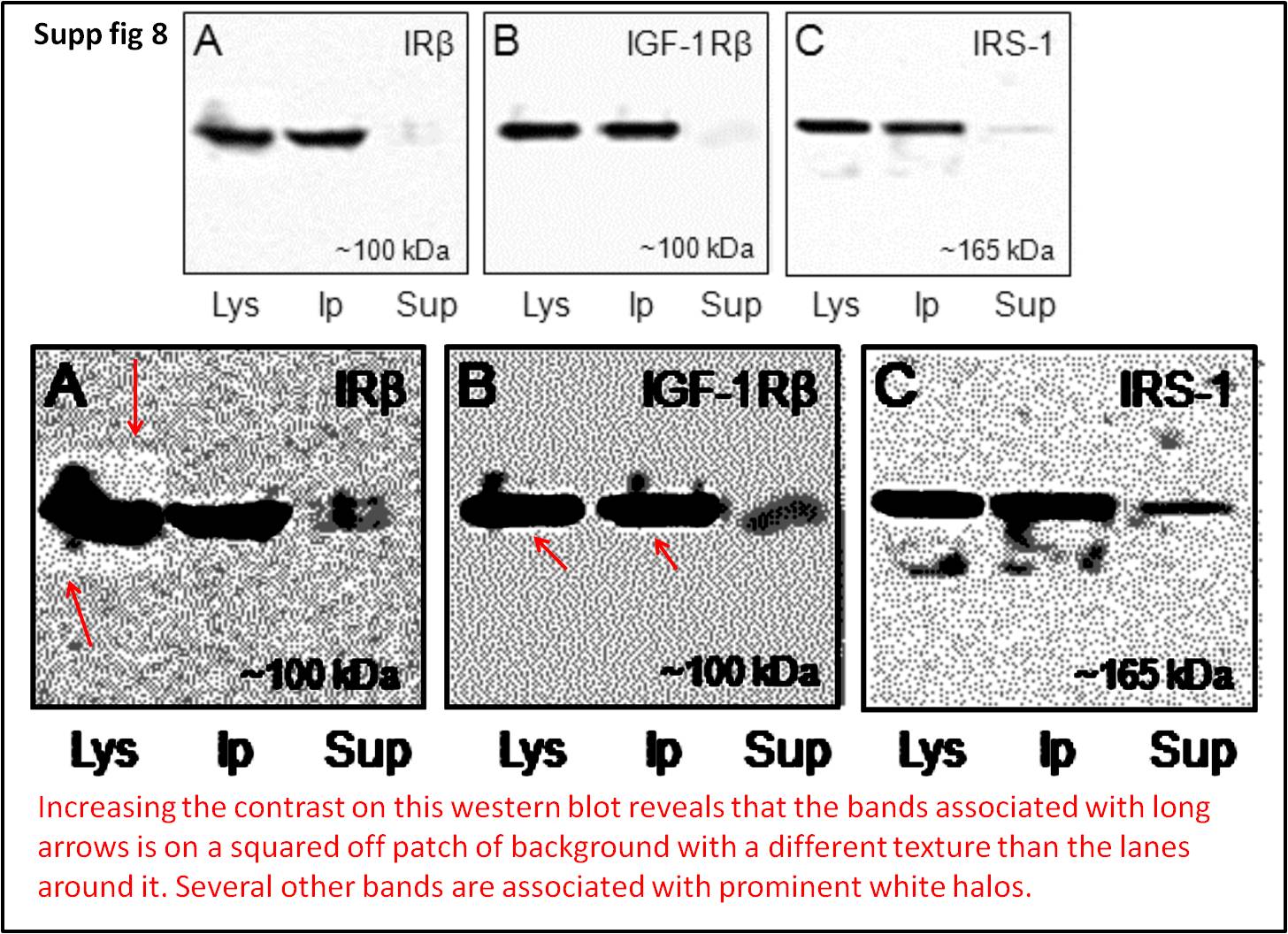

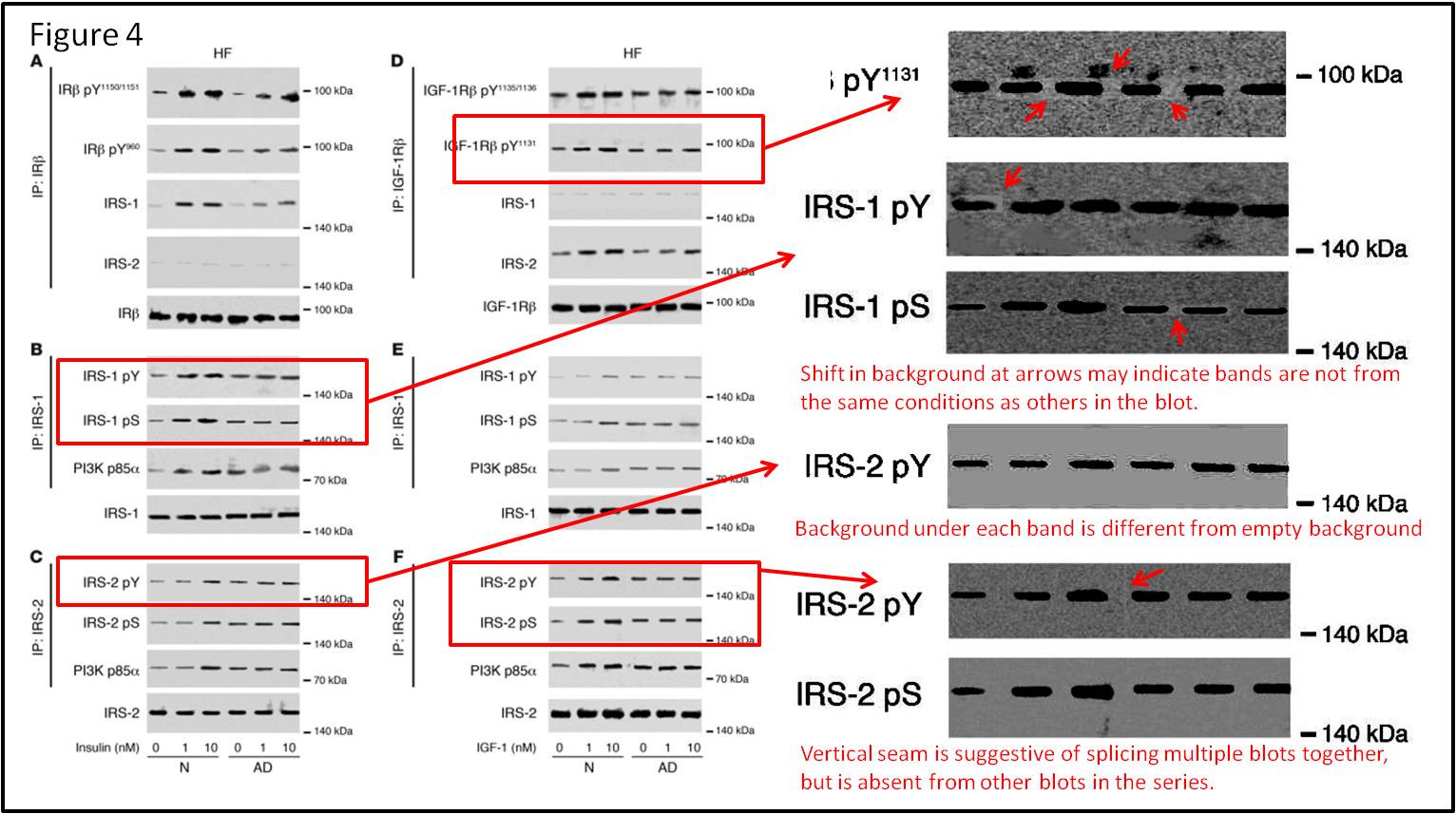
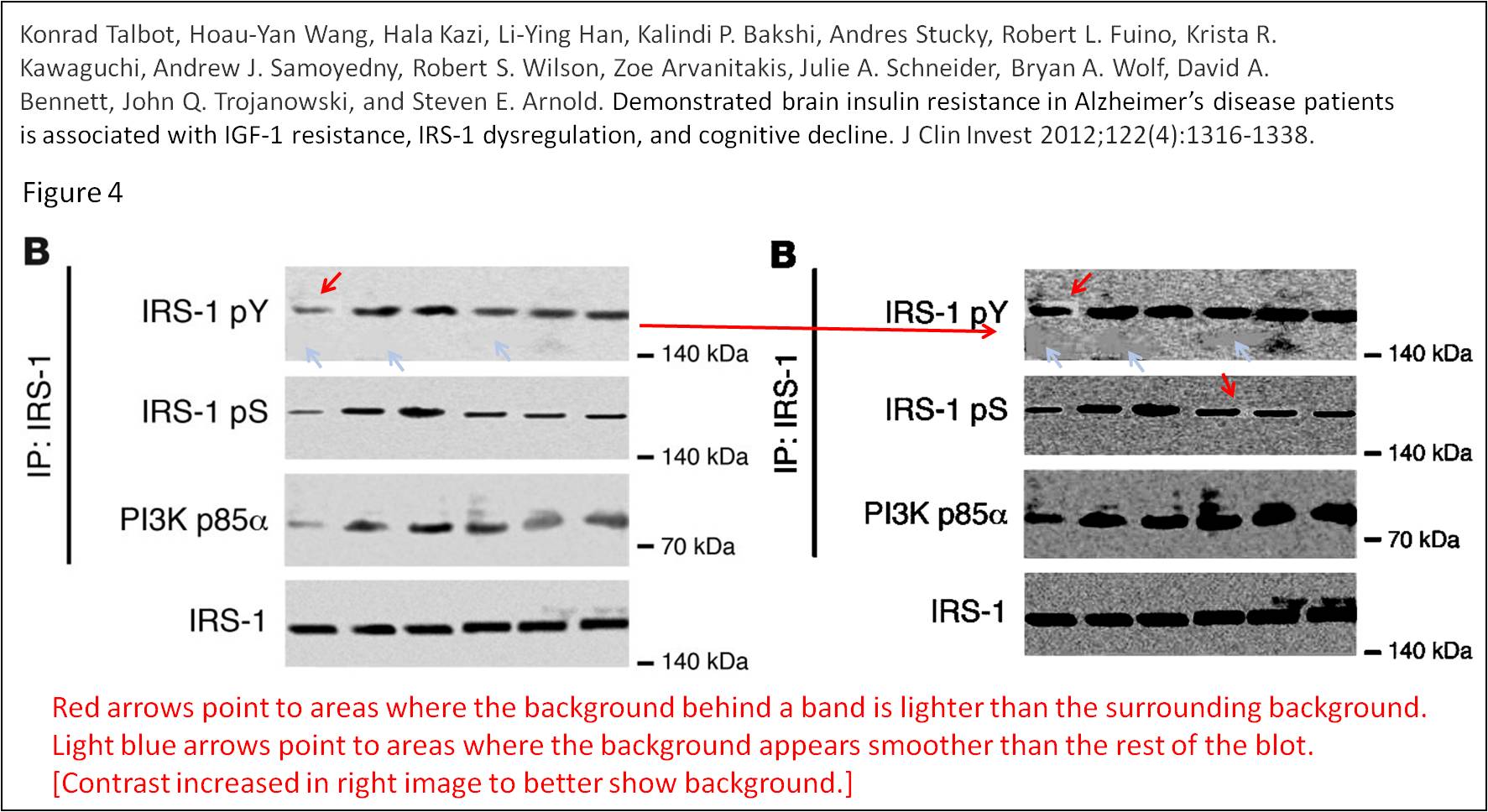

The first author Konrad Talbot form Loma Linda University (whatever that is) kept post lengthy explanation why there is absolutely nothing wrong with those rectangular boxes, but unconvincingly. Then it turned out, the error bars of the graphs were just painted on:

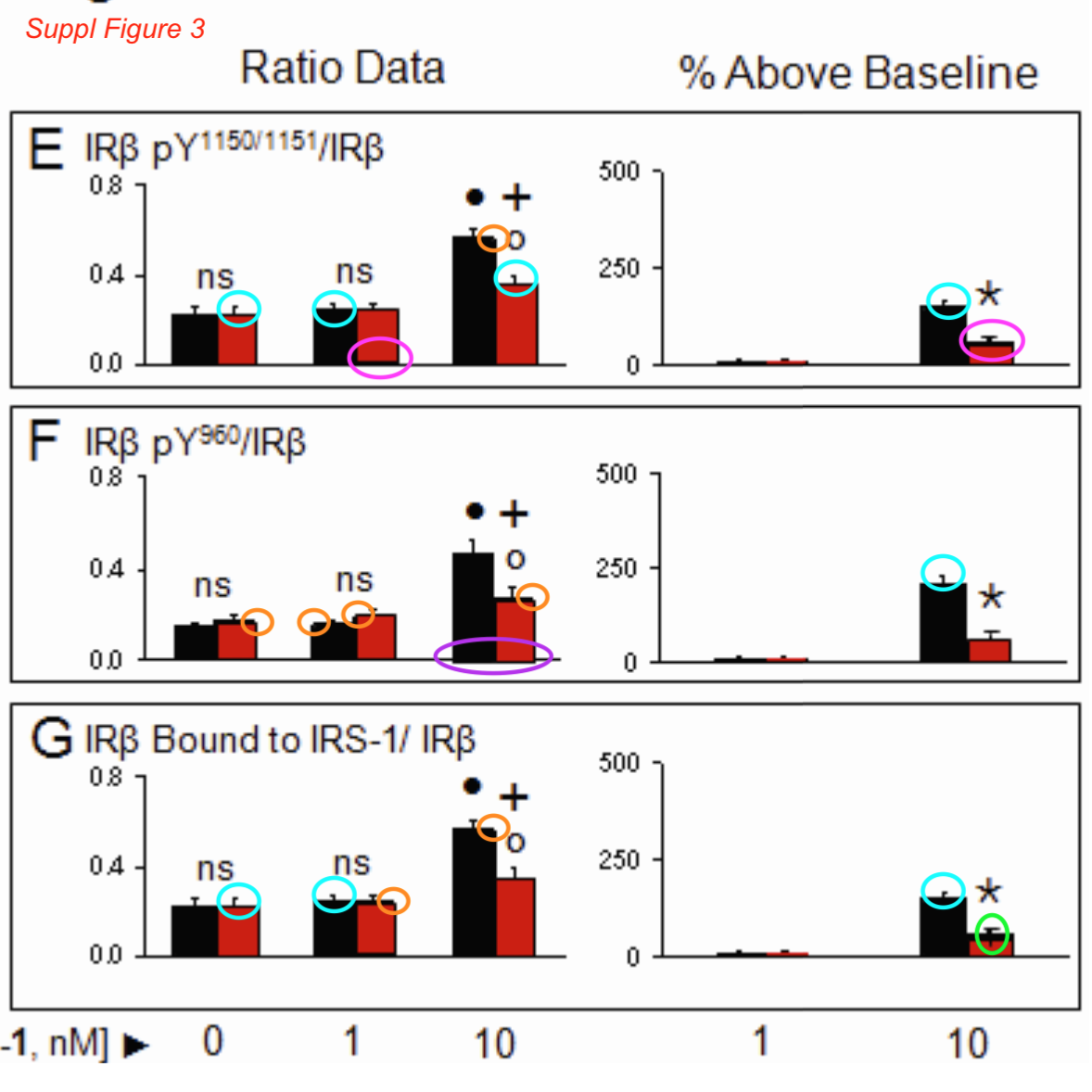

But why does McNally now say that all this is lies and slander and that her
“JCI’s investigation of the allegedly doctored image in its paper did not substantiate the whistle-blowers’”?
The reason is simple: the expert whom JCUI pays to investigate data integrity concerns is the Israeli Dror Kolodkin-Gal and his little company Proofig. Dror is the husband of the research cheater and Weizmann Institute group leader Ilana Kolodkin-Gal, whom I wrote about before:
The PubPeer Stars of Weizmann Institute
Rony Seger, Jacob Hanna, Ilana Kolodkin-Gal, Atan Gross, Sima Lev, Tsvee Lapidot, Moshe Oren, Varda Rotter and others. Let’s celebrate the Weizmann Science!
Dror recently started to send round emails to fellow research cheaters warning them about the dangers of getting caught and offering his paid services of pre-submission screens. He obviously does not believe in research fraud, but rather in the need to save research fraudsters from being exposed and sanctioned, while making good money for himself and his family. McNally knows all this, and this is exactly why she pays Dror’s Proofig to dismiss evidence against fraudulent JCI authors.
Bik recently sent McNally a list of 17 problematic JCI papers. Here it is:
How do you think McNally will deal with those, on Dror’s expert advice?
How to impact
The Wiley journal Advanced Energy Materials sports an awe-inspiring impact factor of almost 30. Here are some clues to their secret, quality science made in China, and flagged on PubPeer by Thallarcha lechrioleuca.
Fazal Raziq , Liqun Sun , Yuying Wang , Xuliang Zhang , Muhammad Humayun , Sharafat Ali , Linlu Bai , Yang Qu , Haitao Yu , Liqiang Jing Synthesis of Large Surface-Area g-C3N4 Comodified with MnOx and Au-TiO2 as Efficient Visible-Light Photocatalysts for Fuel Production Advanced Energy Materials (2018) doi: 10.1002/aenm.201701580
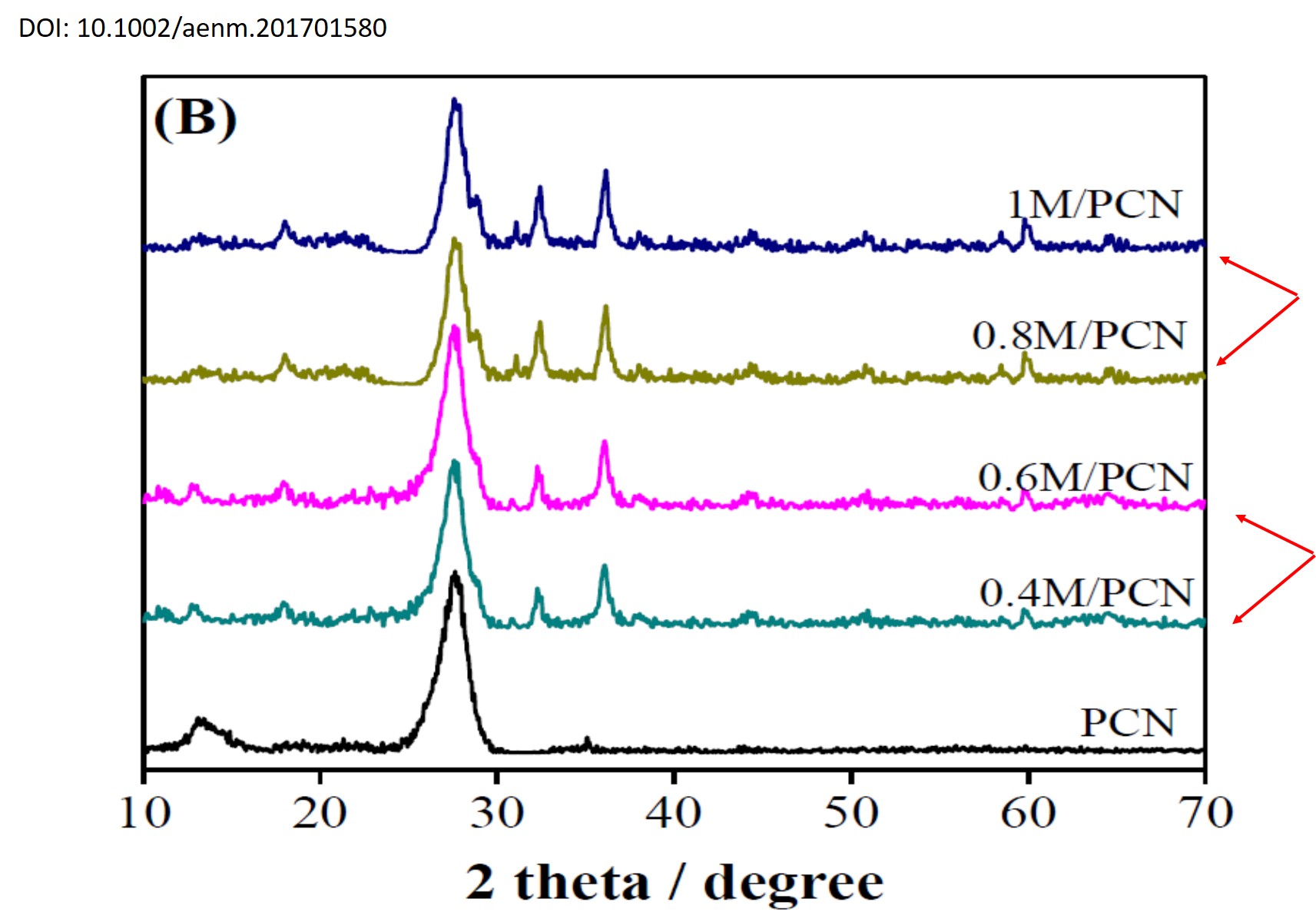
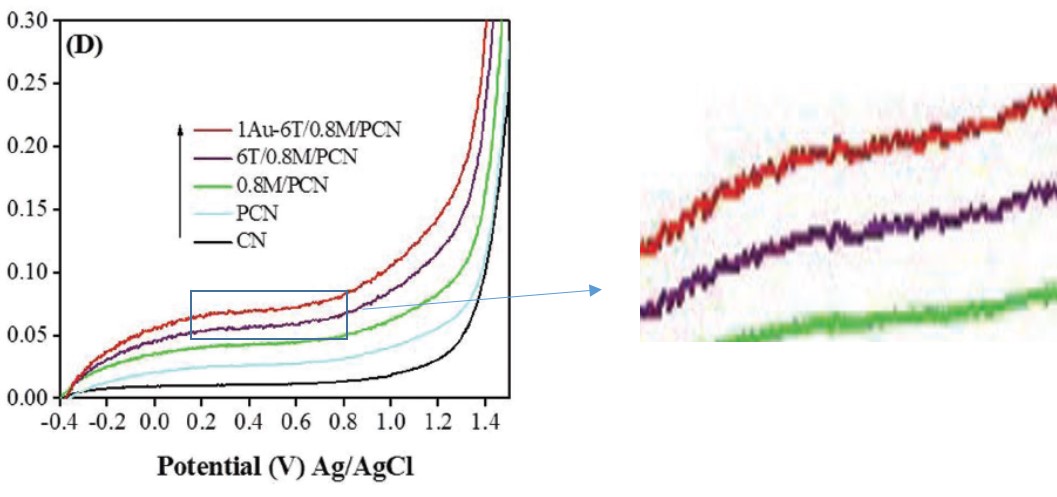

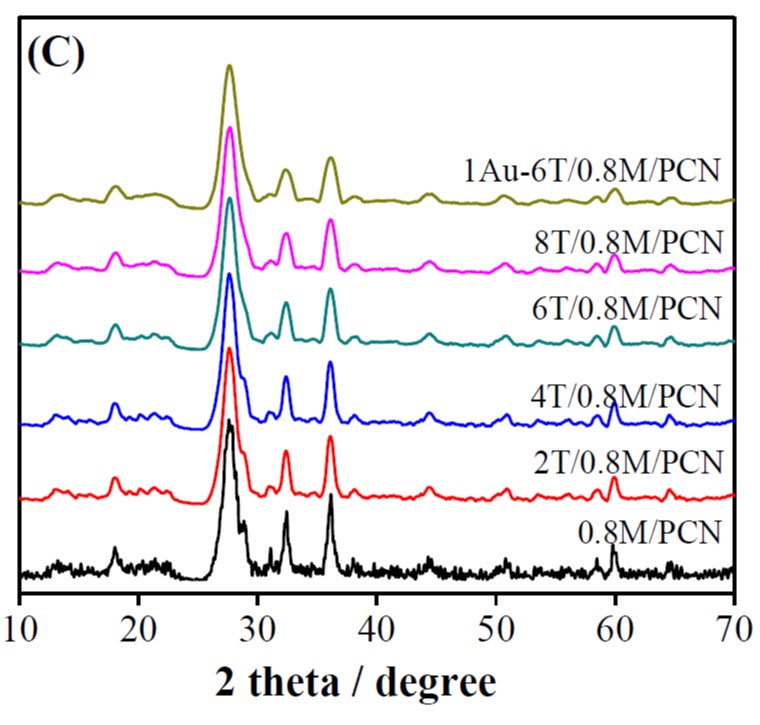

The same Fazal Raziq of University of Electronic Science and Technology of China, Chengdu, and his Chinese friends previously had another paper in the same journal:
Amir Zada , Muhammad Humayun , Fazal Raziq , Xuliang Zhang , Yang Qu , Linlu Bai , Chuanli Qin , Liqiang Jing , Honggang Fu Exceptional Visible-Light-Driven Cocatalyst-Free Photocatalytic Activity of g-C3N4by Well Designed Nanocomposites with Plasmonic Au and SnO2 Advanced Energy Materials (2016) doi: 10.1002/aenm.201601190

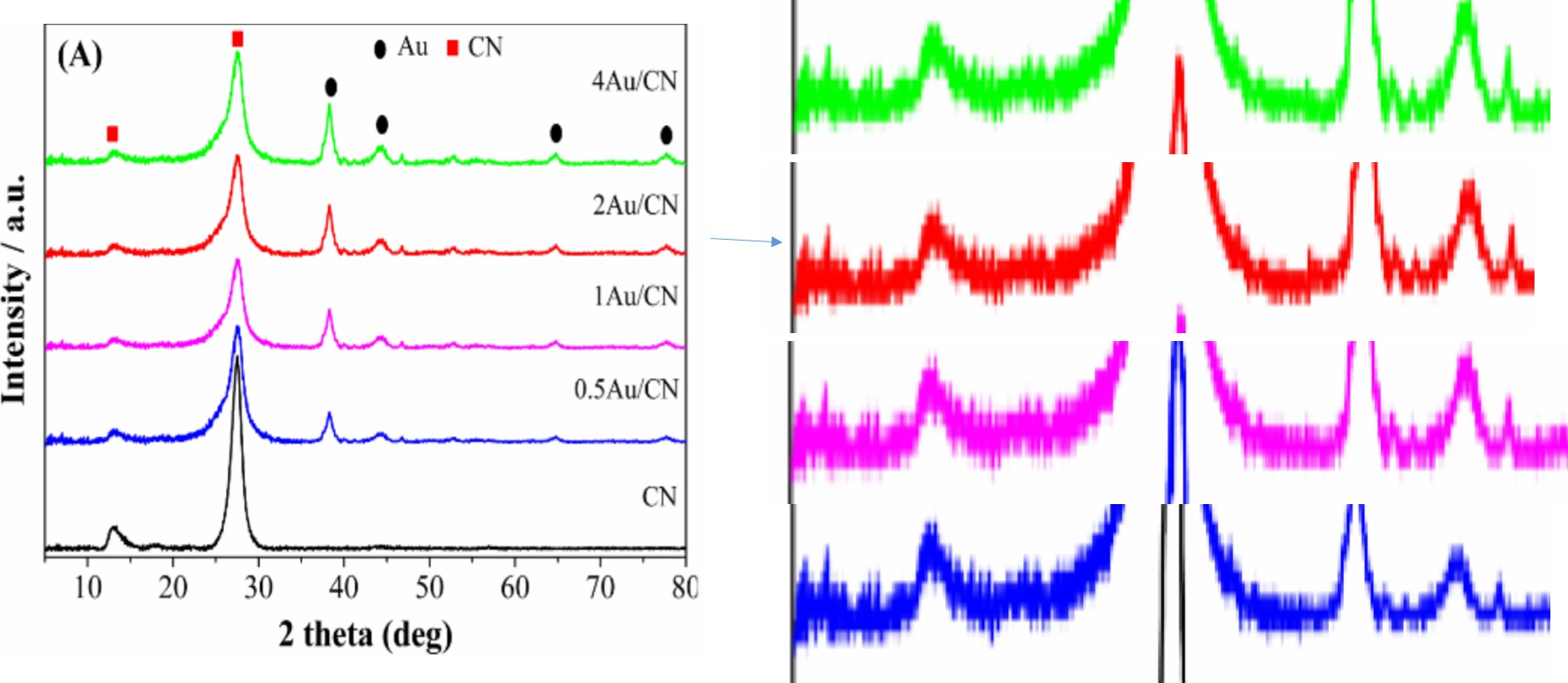


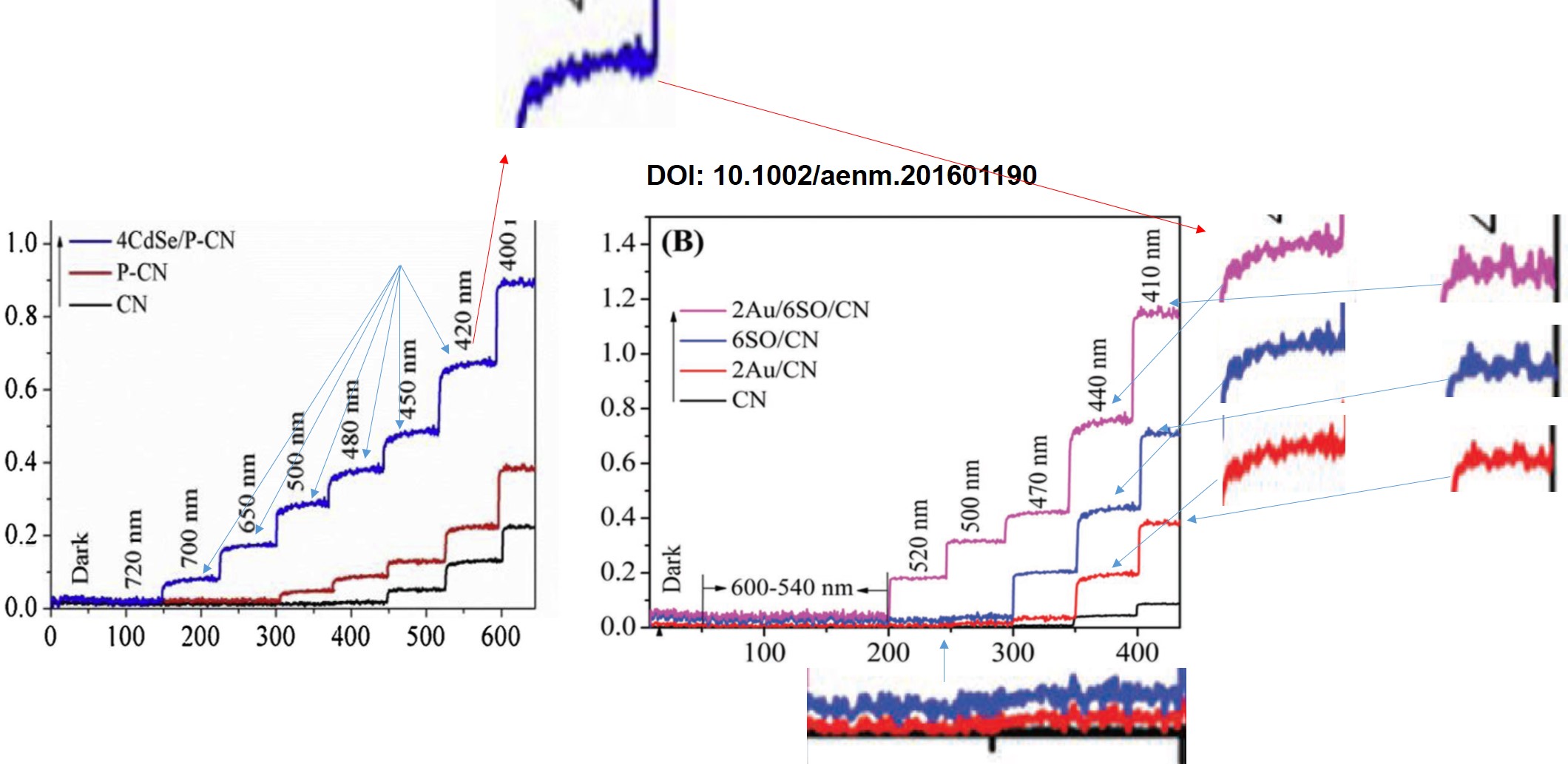
It was this paper, published by Elsevier and sporting an impact factor of 24.3.
Fazal Raziq , Asif Hayat , Muhammad Humayun , Sunil Kumar Baburao Mane , M. Bilal Faheem , Asad Ali , Yang Zhao , Shaobo Han , Chao Cai , Wei Li , Dong-Chen Qi , Jiabao Yi , Xiaojiang Yu , Mark B.H. Breese , Fakhrul Hassan , Farman Ali , Abdurashid Mavlonov , K. Dhanabalan , Xia Xiang , Xiaotao Zu , Sean Li, Liang Qiao Photocatalytic solar fuel production and environmental remediation through experimental and DFT based research on CdSe-QDs-coupled P-doped-g-C3N4 composites Applied Catalysis B: Environmental (2020) doi: 10.1016/j.apcatb.2020.118867
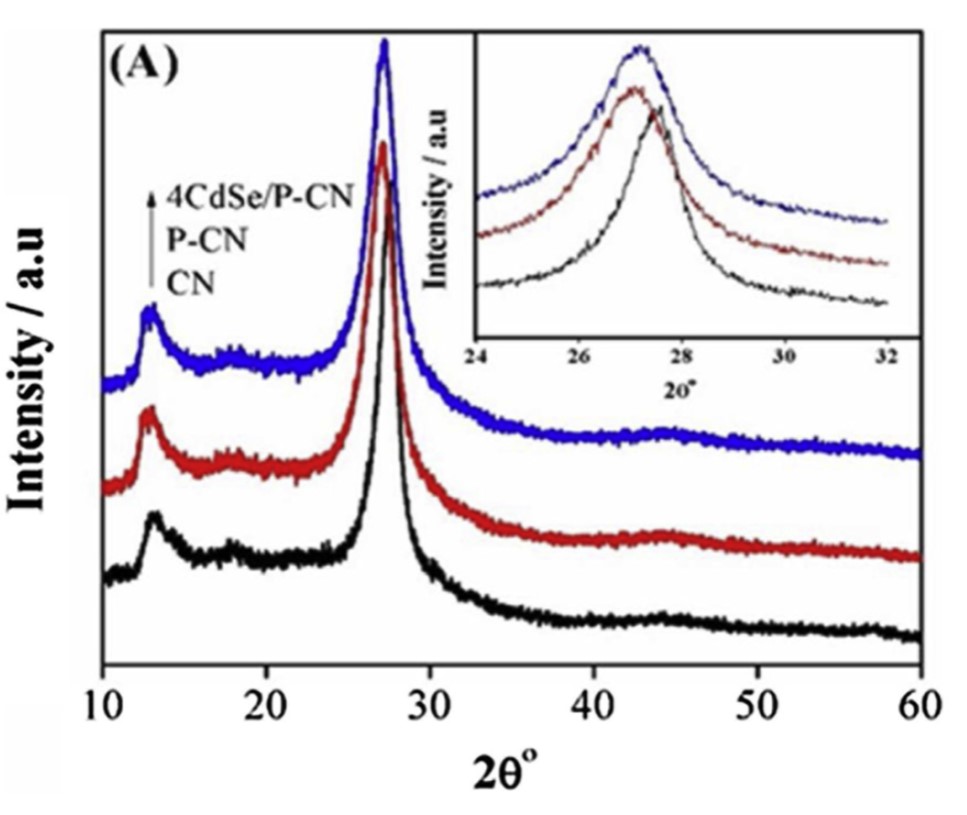
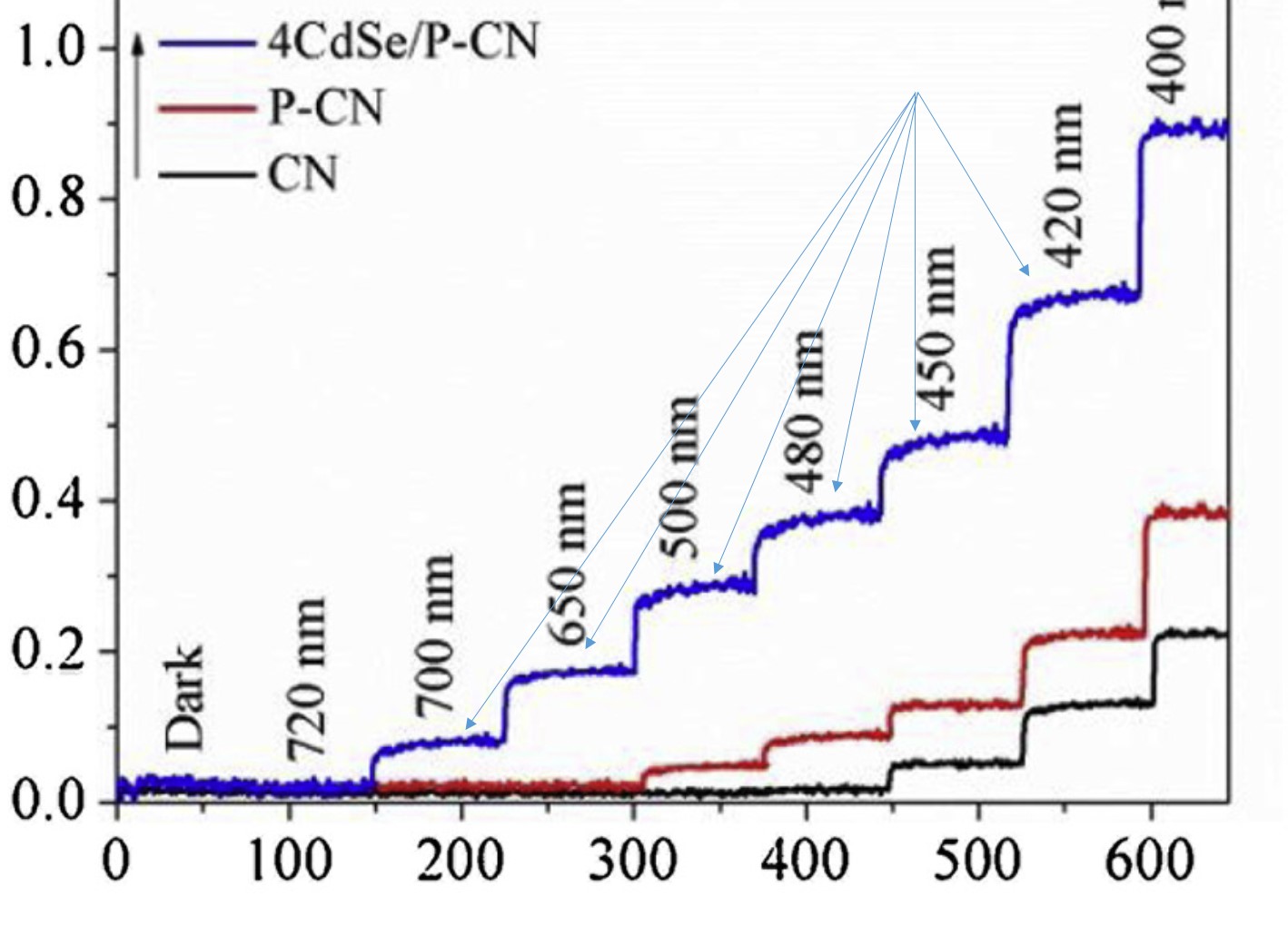

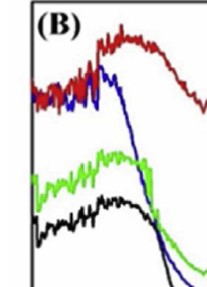
The Raziq gang has currently 6 very fake papers on PubPeer. It is quite likely that Raziq and his partners bought all this trash from papermills, as this paper proves:
Muhammad Farooq Khan , Syed Ul Hasnain Bakhtiar , Amir Zada , Fazal Raziq , Hassan Anwar Saleemi , Muhammad Shahzeb Khan , Pir Muhammad Ismail , Arnold C. Alguno , Rey Y. Capangpangan , Asad Ali , Salman Hayat , Sharafat Ali , Ahmed Ismail , Muhammad Zahid Ag modified ZnO microsphere synthesis for efficient sonophotocatalytic degradation of organic pollutants and CO2 conversion Environmental Nanotechnology, Monitoring & Management (2022) doi: 10.1016/j.enmm.2022.100711

Of course it is entirely impossible that such elite chemistry journals would publish utterly fake fraud, from papermills even, to boost their impact factor. The Deputy Editor of the Wiley journal, Carolina Novo da Silva, announced to me:
“We will investigate this in accordance with COPE guidelines.“
She signed her email with this note:
“Advanced Energy Materials
Impact Factor (2022 Journal Citation Reports): 29,698″
I pointed out to her that Wiley signed the San Francisco Declaration on Research Assessment (DORA) in May 2022, where Wiley announced, their own words:
“By becoming a DORA signatory, we’re formally committing to the 5 recommendations outlined for publishers:
1. Greatly reduce emphasis on the journal impact factor (IF) as a promotional tool
No reply. Haha, Wiley again lied to everyone.
Wiley: Committed to integrity? Get out!
“We have initiated post-acceptance peer review with independent reviewers… ” – Wiley.
News in Tweets
- Nature: “Anna Abalkina, an economist at the Free University of Berlin, and Nick Wise, an engineer at the University of Cambridge, UK, independently began investigating the adverts when they first started appearing in large numbers in 2019. Abalkina focuses on adverts on websites originating in Russia and Eastern Europe, and Wise looks at those circulated on Facebook and Telegram.”
- And here Nature celebrates the upcoming technological breakthrough: “Publishers are testing prototypes of automatic systems to flag submitted manuscripts bearing the hallmarks of paper mills […] Companies involved in the initiative include BMJ, Elsevier, Frontiers, IOP Publishing, the JAMA Network, Sage Publishing, Taylor & Francis, Wiley and Springer Nature […] Joris van Rossum, director of research integrity at STM, says that the organization hopes to have versions of the paper-mill detection and duplicate-submission alerts available for wider use by early next year.” Here is my 2 cent trolling: if this even works, do you publishers have plans for an alternative business model once you got rid of papermill fraud? What do you intend to publish then, have you really thought thsi through?
- In this regard, Mike Rossner in Scholarly Kitchen: “I am concerned that editors will become reliant on software to settle similar matters in the future without fully understanding what it can and cannot do.“
- Ah, but Elsevier’s International Journal of Hydrogen Energy is family business run by Veziroglu Senior and Junior, which specialises on publishing fraud.
Erdogan’s academic elites
Önder Metin had a rogue PhD student whom he trusted “to ensure their academic growth”. But “mistakes were made by mistake”, conclusions are never affected. Yet those who still complain, will pay dearly.
- A weighty argument why the current scholarly publishing system is the best one can have: Husain et al, “Measuring Sexual Intelligence for Evaluating Sexual Health” (2023). In a journal published by Sage, Editor-in-Chief Cory Scherer, associate professor at Penn State Schuylkill, USA.
- Wired writes: “PubPeer is the sort of place where you might want to be anonymous. There, under randomly assigned taxonomic names like Actinopolyspora biskrensis (a bacterium) and Hoya camphorifolia (a flowering plant), “sleuths” meticulously document mistakes in the scientific literature.” Sure, dear Smut Clyde, everyone by now knows who you are. A friend of that Nazi sexual harasser satanic reptiloid baby-eating antichrist Schneider, and that’s why nobody is keen to talk to you.
- Can’t agree more.
I thank all my donors for supporting my journalism. You can be one of them!
Make a one-time donation:
I thank all my donors for supporting my journalism. You can be one of them!
Make a monthly donation:
Choose an amount
Or enter a custom amount
Your contribution is appreciated.
Your contribution is appreciated.
DonateDonate monthly

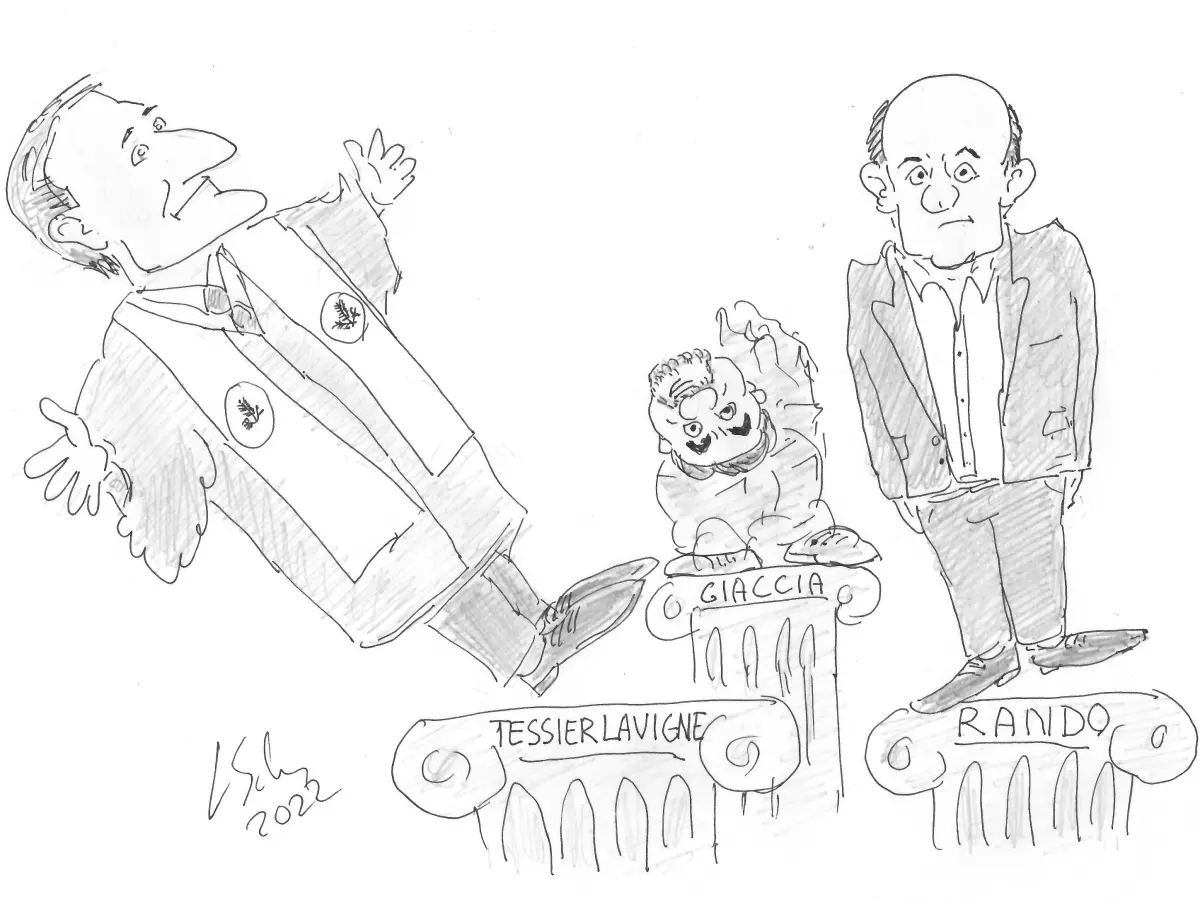





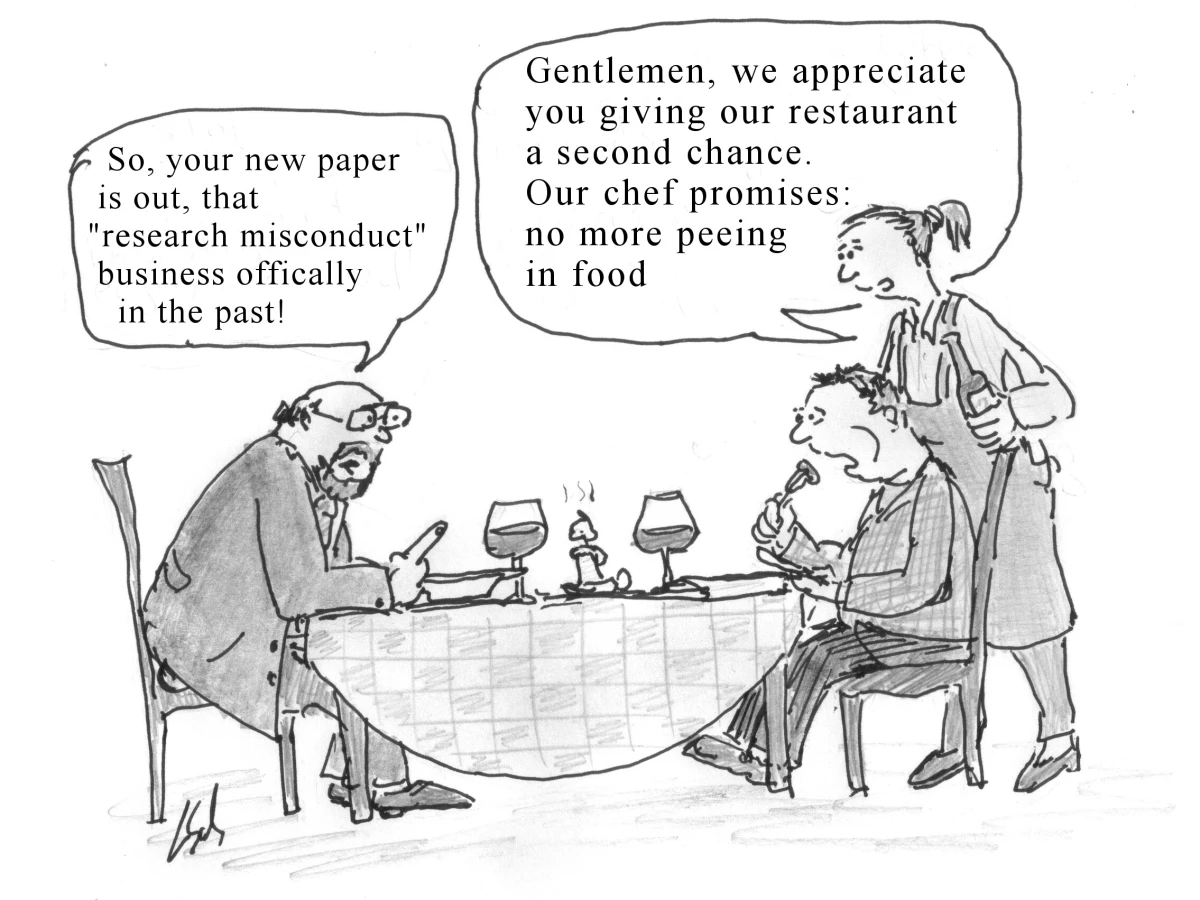



Imperial College, problems at the top.
https://en.wikipedia.org/wiki/Hugh_Brady_(academic)
Hugh Redmond Brady, not to be confused with Hugh JM Brady also at imperial.
https://www.imperial.ac.uk/news/238631/imperial-welcomes-president/
“Professor Brady, a renowned medic and university leader, has joined Imperial College London after spending seven years as Vice-Chancellor and President of the University of Bristol.
He formerly served as the youngest-ever President of University College Dublin (UCD), Ireland’s largest research-intensive university. His academic career also included roles at Harvard Medical School, the University of Toronto and UCD.
An international authority on the pathogenesis of renal inflammation and diabetic kidney disease, Professor Brady is the first medic to lead Imperial. ”
Problematic data 5 papers Hugh R Brady, UCD, renal physiology and diabetic kidney disease.
https://pubpeer.com/search?q=hugh+r+brady
LikeLike
Just as mentoring by Tyler Jacks was important for the career progression of Elsa Flores
https://forbetterscience.com/2023/01/09/what-elsa-flores-and-tyler-jacks-taught-each-other/
mentoring by Hugh Redmond Brady was important for the career progression of 2 of his coauthors,
1. Catherine Godson, and
2. John Crean,
both now professors at University College Dublin (UCD).
Full Professor Catherine Godson.https://www.ucd.ie/medicine/research/researchcentres/ucddiabetescomplicationsresearchcentre/meettheteam/https://www.ucd.ie/medicine/studywithus/ourstaff/professorcatherinegodson/
Pubpeer record Catherine Godson:https://pubpeer.com/search?q=catherine+godson
Associate Professor John Creanhttps://www.ucd.ie/medicine/research/researchcentres/ucddiabetescomplicationsresearchcentre/meettheteam/https://people.ucd.ie/john.crean/professional
Pubpeer record John Crean:https://pubpeer.com/search?q=john+crean
This is a highly imaginative paper:https://pubpeer.com/publications/DE40A05BA7876D0712D3A7CB44D26D
You have to see it to believe how imaginative it is.
A paper commented on in 2014, coauthored by Catherine Godson, and John Crean, with the highly successful businesswoman, Professor Therese Kinsella.https://pubpeer.com/publications/D03FE989CEF2A6370550BA2BCE9054
https://www.ucd.ie/sbbs/about/academicstaff/4/https://people.ucd.ie/therese.kinsellahttps://www.atxatherapeutics.com/our-team
A leading expert according to THE ROYAL IRISH ACADEM https://www.ria.ie/ga/node/91570https://pubpeer.com/publications/D03FE989CEF2A6370550BA2BCE9054
https://retractionwatch.com/2018/08/10/researcher-and-biotech-founder-in-ireland-issues-four-retractions/
Professor Therese Kinsella’s Pubpeer record: https://pubpeer.com/search?q=therese+kinsella
Professor Therese Kinsella’s Retraction Watch database entry:http://retractiondatabase.org/RetractionSearch.aspx#?auth%3dKinsella%252c%2bB%2bTherese
Hugh Redmond Brady has left a lasting legacy at University College Dublin (UCD),
of which he and University College Dublin (UCD) can be rightly proud.
There might be something Rotten in the State of Denmark, but that is another matter.
LikeLike
https://www.standard.co.uk/news/education/imperial-college-london-hugh-brady-unwelcome-international-students-b1055785.html
Hugh Brady, President Imperial talks about the best talent. Would he say that he is the best talent, or a careerist manager?
https://www.standard.co.uk/news/education/hugh-brady-imperial-college-research-funding-golden-triangle-universities-b1056089.html
Hugh Brady talks about excellence. Would he say that his science,
and scientific legacy, at University College Dublin fell into the category “excellent”?
LikeLike
J Biol Chem. 2000 Sep 8;275(36):27566-75. doi: 10.1074/jbc.M001015200.
Lipoxin A4 antagonizes the mitogenic effects of leukotriene D4 in human renal mesangial cells. Differential activation of MAP kinases through distinct receptors
B McMahon 1, C Stenson, F McPhillips, A Fanning, H R Brady, C Godson
Affiliation
1Centre for Molecular Inflammation and Vascular Research, Department of Medicine and Therapeutics, Mater Misericordiae Hospital and the Conway Institute of Biomolecular and Biomedical Research, University College Dublin, 41 Eccles St., Dublin 7, Ireland.
PMID: 10869343 DOI: 10.1074/jbc.M001015200
Figure 7A. Much more similar than expected.
https://pubpeer.com/publications/EFDDA21C963806639152DDEB07343F#1
LikeLike
Of course they push towards getting more international students. Foreigners have to pay at least 3 times more for tuition fees! It is just a great business for them and has nothing to do with equality and diversity. Otherwise, everyone would pay the same amount of money for tuition fees, regardless of their nationality.
The reality of being an international student in the UK :https://www.theguardian.com/education/2015/jul/02/get-a-job-or-get-out-the-tough-reality-for-international-students
Murdoch University sued the whistleblower, Gerd Schroeder-Turk.
https://www.macrobusiness.com.au/2019/10/international-student-critics-crucified-by-greedy-university-overloards/
LikeLike
J Am Soc Nephrol. 2008 Sep; 19(9): 1672–1680.
doi: 10.1681/ASN.2007101080
PMCID: PMC2518434
PMID: 18508967
IHG-1 Amplifies TGF-β1 Signaling and Is Increased in Renal Fibrosis
Madeline Murphy,* Neil G. Docherty,* Brenda Griffin,* Jillian Howlin,* Emmett McArdle,* Ruth McMahon,* Holger Schmid,† Matthias Kretzler,† Alejandra Droguett,‡ Sergio Mezzano,‡ Hugh R. Brady,* Fiona Furlong,* Catherine Godson,* and Finian Martin*
Author information
*UCD Diabetes Research Centre, Conway Institute, Schools of Medicine and Medical Science and Biomolecular and Biomedical Science, University College Dublin, Belfield, Dublin, Ireland; †Medizinische Poliklinik, Ludwig-Maximilians-University of Munich, Munich, Germany; and ‡Department of Nephrology, Universidad Austral, Valdivia, Chile
Correspondence: Dr. Madeline Murphy, UCD Conway Institute of Biomolecular and Biomedical Research, University College Dublin, Belfield, Dublin 4, Ireland. Phone: +353-1-7166818; Fax: +353-1-7166713; E-mail: madeline.murpht@ucd.ie
Problematic data figure 1C. Much more similar than expected.
Problematic data figures 5B and 5C. Much more similar and different than expected.
LikeLike
J Biol Chem. 2002 Mar 22;277(12):9707-12.
doi: 10.1074/jbc.M109172200. Epub 2002 Jan 9.
High glucose-altered gene expression in mesangial cells. Actin-regulatory protein gene expression is triggered by oxidative stress and cytoskeletal disassembly
Michael R Clarkson 1 , Madeline Murphy, Sunil Gupta, Teresa Lambe, Harald S Mackenzie, Catherine Godson, Finian Martin, Hugh R Brady
Affiliation
Problematic data figure 3. Bands ARP 3 and MRLC panels, have vertical straight ends, whereas bands in other 2 panels do not have straight, vertical ends.
Problematic data figure 4A. Much more similar than expected.
LikeLike
FASEB J. 2002 Nov;16(13):1817-9.
doi: 10.1096/fj.02-0416fje. Epub 2002 Sep 5.
Lipoxin, leukotriene, and PDGF receptors cross-talk to regulate mesangial cell proliferation
Blaithin McMahon 1 , Derick Mitchell, Richard Shattock, Finian Martin, Hugh R Brady, Catherine Godson
Affiliation
Problematic data figures 1A and 1C. Much more similar and different than expected.
LikeLike
Mrs Brady old lady is likely a better scientist than Prof Hugh R Brady, President ( that’s with a capital P) of Imperial College, careerist manager at University College Dublin, University of Bristol, with poor data.
https://www.theguardian.com/culture/cartoon/2009/nov/07/2
LikeLike
https://www.timeshighereducation.com/news/imperial-college-professor-stefan-grimm-was-given-grant-income-target/2017369.article#:~:text=An%20email%20sent%20in%20March,being%20awarded%20at%20least%20one
Although Hugh Brady was not President of Imperial at the time of Stefan Grimm’s suicide he is President of Imperial now. Could Hugh Brady deny that Imperial College got its sums wrong and that in fact Stefan Grimm had reached the target for required funding and that the accountant who discovered that Imperial had got its sums wrong was silenced?
LikeLike
https://www.timeshighereducation.com/news/imperial-college-professor-stefan-grimm-was-given-grant-income-target/2017369.article
https://www.imperial.ac.uk/people/m.wilkins
https://pubpeer.com/publications/272C43BBB584629616EBF30C151152
https://pubpeer.com/publications/B776F207111D4FB32DA34F27F45131
Just like Hugh Brady, President of Imperial, was talking about the best talent, and excellence, would Martin R Wilkins like to comment on the best talent and excellence in his own papers?
LikeLike
Hi Leonid,
Just though you might get a chuckle from this:
https://www.haaretz.co.il/science/2023-01-20/ty-article-magazine/.premium/00000185-bf85-da5d-afb7-bfadc12f0000?gift=2df95cec14544a44b1cb8d831df8cc12
So it’s in Hebrew, but it’s a story about fraud in science etc etc. They interview Bik, Oransky, so on; but also – Dror Klodokin-Gal – regarding Proofig. I tried to post a comment pointing to Pubpeer and your blog, but it’s getting filtered so far.
Have a nice weekend,
D
LikeLike
Indeed, I can’t be mentioned in Israeli media, everyone knows I am a Nazi antisemite, just like that other evil Ukrainian Jew, Zelensky.
This is great:
They don’t say that the colleagues was his wife Ilana. Because Schneider is a Nazi, remember?
LikeLike
They even have a paper from last year together https://www.cell.com/iscience/fulltext/S2589-0042(22)00504-1, the fox guarding the henhouse, how lovely. Wondering (or maybe not) whether it got Proofig approved…
Looking at the Proofig site, it is immediately evident that these “scientists” read very carefully the “Nazi” blogs and bloggers and even take notes. Wouldn’t be surprised some of the images there to be directly taken from here and/or other fellow research integrity experts. Maybe the whole idea behind this software is to alert the “true scientists” where the “Nazis” can spot the image manipulation so that it can be dealt with before publication.
Finally to note that the focus has been deliberately shifted from fraud to mistakes.
LikeLiked by 1 person
Oh yes, Dror doesn’t believe in research fraud, just innocent mistakes. But he is not the only watchdog to push this religion: see Daniele Fanelli, Lex Bouter, Arturo Casadevall, and many others.
LikeLiked by 1 person
“very special scientist from Georgia (the country in Caucasus, not the US state ruled by “Caucasians”)”
LOL Well done
LikeLiked by 2 people
Pingback: O’s & Jerrie’s digest – ocasapiens
First author of the faulty Nature Comm paper has long found shelter in Strasbourg in a well known institute where cheating is commonplace http://www.ibmp.cnrs.fr/annuaire/yihan-dong/?lang=en
LikeLiked by 1 person
RETRACTION to Dong et al. 2017 Nat Comm, 4 May 2023:
https://www.nature.com/articles/s41467-023-38298-8
The authors are retracting this Article after they became aware that Fig. 2g, 3a, 3d, 4b-d, 5a, 5d, and Supplementary Fig. 1a were prepared in an inappropriate manner. The blot images shown in Fig. 2g, 3a, 3d, 4b, 5a and 5d assess TOR activity and autophagy, and were produced by assembling different sections of the original blot images in a way that did not indicate the splicing and merging of lanes, and in some cases the loading controls shown did not correspond to the correct gels/blots. In addition, background sections of the plant images shown in Fig. 4c-d had been duplicated. Finally, the gel images shown in Supplementary Fig. 1a to confirm plant genotypes contain internal duplications and the original data cannot be found. Subsequent genotyping data has confirmed the genotype of the plants and the authors continue to believe that the data on TOR activity and autophagy are supported. The authors maintain full confidence in the metabolic profiling and transcriptomic data in the paper. Nevertheless, they recognize that the irregularities in image presentation could collectively decrease confidence in the conclusions. The authors apologise to the scientific community for any confusion caused by these errors. All authors agree to this retraction.
LikeLike
Stanford president resigns over manipulated research, will retract at least three papers
Marc Tessier-Lavigne failed to address manipulated papers, fostered unhealthy lab dynamic, Stanford report says
LikeLiked by 1 person
Oh… The WSJ caught up with what happened at Stanford.
The Band of Debunkers Busting Bad Scientists
Stanford’s president and a high-profile physicist are among those taken down by a growing wave of volunteers who expose faulty or fraudulent research papers
https://www.wsj.com/science/data-colada-debunk-stanford-president-research-14664f3
‘An award-winning Harvard Business School professor and researcher spent years exploring the reasons people lie and cheat. A trio of behavioral scientists examining a handful of her academic papers concluded her own findings were drawn from falsified data. It was a routine takedown for the three scientists — Joe Simmons, Leif Nelson and Uri Simonsohn — who have gained academic renown for debunking published studies built on faulty or fraudulent data. They use tips, number crunching and gut instincts to uncover deception. Over the past decade, they have come to their own finding: Numbers don’t lie but people do.
“Once you see the pattern across many different papers, it becomes like a one in quadrillion chance that there’s some benign explanation,” said Simmons, a professor at the Wharton School of the University of Pennsylvania and a member of the trio who report their work on a blog called Data Colada. Simmons and his two colleagues are among a growing number of scientists in various fields around the world who moonlight as data detectives, sifting through studies published in scholarly journals for evidence of fraud. At least 5,500 faulty papers were retracted in 2022, compared with 119 in 2002, according to Retraction Watch, a website that keeps a tally. The jump largely reflects the investigative work of the Data Colada scientists and many other academic volunteers, said Dr. Ivan Oransky, the site’s co-founder. Their discoveries have led to embarrassing retractions, upended careers and retaliatory lawsuits.
Neuroscientist Marc Tessier-Lavigne stepped down last month as president of Stanford University, following years of criticism about data in his published studies. Posts on PubPeer, a website where scientists dissect published studies, triggered scrutiny by the Stanford Daily. A university investigation followed, and three studies he co-wrote were retracted. Stanford concluded that although Tessier-Lavigne didn’t personally engage in research misconduct or know about misconduct by others, he “failed to decisively and forthrightly correct mistakes in the scientific record.”
LikeLike